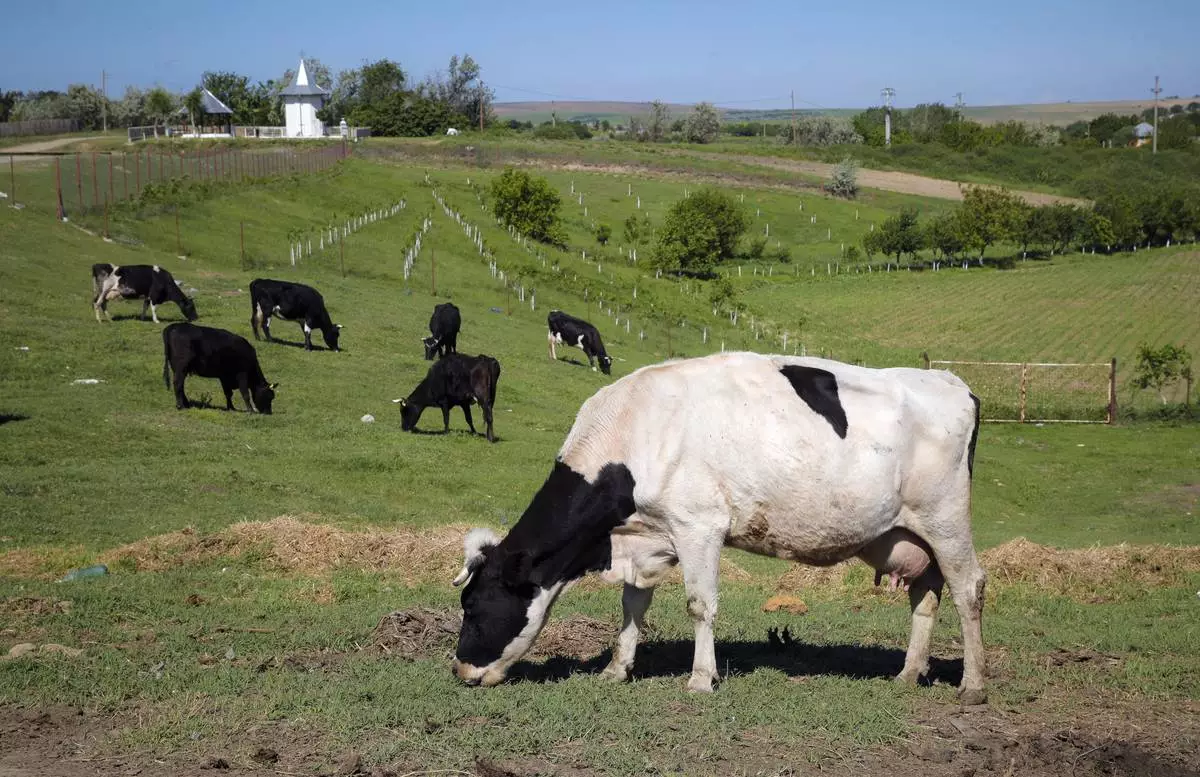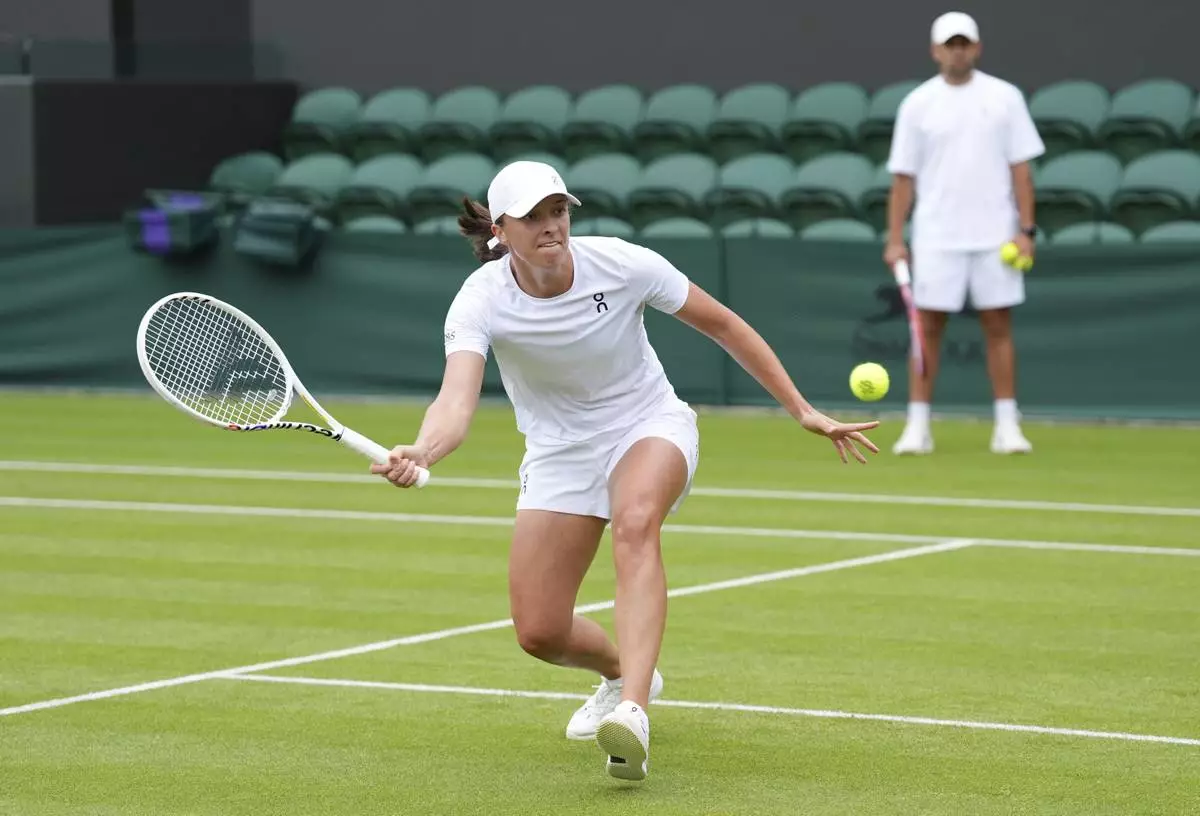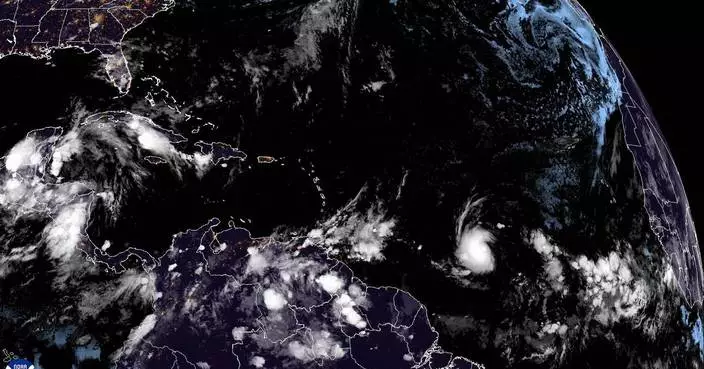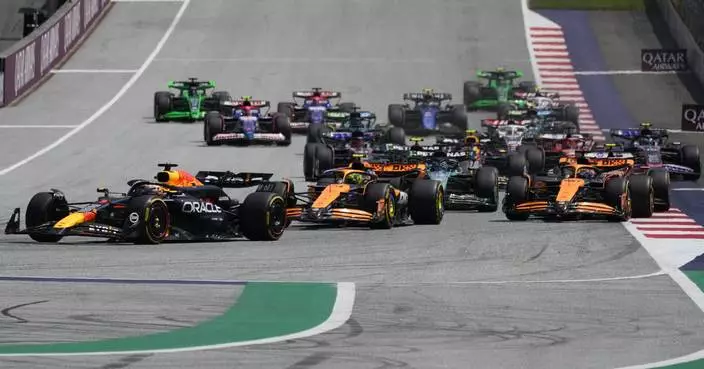COPENHAGEN, Denmark (AP) — Denmark will tax livestock farmers for the greenhouse gases emitted by their cows, sheep and pigs from 2030, the first country to do so as it targets a major source of methane emissions, one of the most potent gases contributing to global warming.
The aim is to reduce Danish greenhouse gas emissions by 70% from 1990 levels by 2030, said Taxation Minister Jeppe Bruus.
As of 2030, Danish livestock farmers will be taxed 300 kroner ($43) per ton of carbon dioxide equivalent in 2030. The tax will increase to 750 kroner ($108) by 2035. However, because of an income tax deduction of 60%, the actual cost per ton will start at 120 kroner ($17.3) and increase to 300 kroner by 2035.
Although carbon dioxide typically gets more attention for its role in climate change, methane traps about 87 times more heat on a 20-year timescale, according to the U.S. National Oceanic and Atmospheric Administration.
Levels of methane, which is emitted from sources including landfills, oil and natural gas systems and livestock, have increased particularly quickly since 2020. Livestock account for about 32% of human-caused methane emissions, says the U.N. Environment Program.
“We will take a big step closer in becoming climate neutral in 2045,” Bruus said, adding Denmark “will be the first country in the world to introduce a real CO2 tax on agriculture” and hoped other countries would follow suit.
New Zealand had passed a similar law due to take effect in 2025. However, the legislation was removed from the statute book on Wednesday after hefty criticism from farmers and a change of government at the 2023 election from a center-left ruling bloc to a center-right one. New Zealand said it would exclude agriculture from its emissions trading scheme in favor of exploring other ways to reduce methane.
Almost all of the methane from raising livestock, some 90%, comes from the way they digest, through fermentation, and is released as burps through their mouths. Cows make up most of this belched methane. Most of the remaining 10% of livestock methane comes off manure ponds on both pig and cattle operations.
In Denmark, the deal was reached late Monday between the center-right government and representatives of farmers, the industry and unions, among others, and presented Tuesday.
Denmark's move comes after months of protests by farmers across Europe against climate change mitigation measures and regulations that they say are driving them to bankruptcy.
The Danish Society for Nature Conservation, the largest nature conservation and environmental organization in Denmark, described the tax agreement as “a historic compromise.”
"We have succeeded in landing a compromise on a CO2 tax, which lays the groundwork for a restructured food industry -– also on the other side of 2030,” its head Maria Reumert Gjerding said after the talks in which they took part.
A typical Danish cow produces 6 metric tons (6.6 tons) of CO2 equivalent per year. Denmark, which is a large dairy and pork exporter, also will tax pigs although cows produce far higher emissions than pigs.
The tax is to be approved in the 179-seat Folketing, or parliament, but the bill is expected to pass after the broad-based consensus.
According to Statistic Denmark, there were as of June 30, 2022, 1,484,377 cows in the Scandinavian country, a slight drop compared to the previous year.
Read more of AP’s climate coverage at http://www.apnews.com/climate-and-environment
Associated Press writer Charlotte Graham-McLay in Wellington, New Zealand, contributed to this report.

FILE - Cows graze in a field in Luncavita, Romania, on May 21, 2019. Denmark will impose cattle farmers with a tax on livestock carbon dioxide emissions from 2030, claiming it will be the first country to do so, in a move to reduce greenhouse gas emissions from each of their cows. (AP Photo/Vadim Ghirda, File)
WIMBLEDON, England (AP) — Shortly after Iga Swiatek completed the most lopsided French Open final in 17 years, ceding a grand total of three games against an overmatched opponent to claim a third consecutive title in Paris, she was asked whether that represented a perfect performance.
Swiatek's mind immediately went to what little went wrong in Court Philippe Chatrier that afternoon.
“Obviously, I mean, I got broken at the beginning,” she said, “so it wasn’t maybe perfect.”
A few minutes later, Swiatek used the word “perfectionist” to describe herself, perhaps offering some insight as to how she is approaching Wimbledon, the grass-court major that begins Monday — and the only Grand Slam tournament where she hasn't been past the quarterfinals.
“Overall, tennis is different on grass,” said Swiatek, who was a junior champion at the All England Club in 2018. “I’ll just see and I’ll work hard to play better there.”
The 23-year-old from Poland has won four of the past five trophies on the red clay at Roland Garros, capped by a 6-2, 6-1 victory against Jasmine Paolini for the championship on June 8.
How does a player beat Swiatek on clay?
“It’s hard. You have to err very little. Match her intensity. Play deep shots. Try to be aggressive whenever there’s an easier ball," said Paolini, who is now ranked in the top 10 but hardly looked that caliber in the final. "But it’s not easy. It wasn’t for me, and it’s a challenge that is the most difficult thing in women’s tennis at the moment. How to do it? I don’t know.”
Swiatek also was the 2022 champion at the hard-court U.S. Open and made it to the Australian Open semifinals on that surface earlier that season. But she is just 9-4 on the grass of the All England Club, by far her worst winning percentage at a Slam.
For someone who talks a lot about wanting to get “better and better,” not to mention someone who wants to do things perfectly on and off the court, it would make sense if she wanted to improve at Wimbledon.
Specifically, that might entail using her serve and her volleys to accumulate more easy points on the slick surface.
As it is, there isn’t much time spent on grass during the grind of the season, and Swiatek pulled out of a tuneup event on that surface after the French Open. She thinks — hopes? — that “competing every year at Wimbledon and practicing these couple of weeks makes you progress” on grass, and noted that while she at one point considered a training block on it during the offseason, her coach put a stop to that.
During the victory against Paolini for the championship at Roland Garros, Swiatek won 5 of 11 points when she went to the net.
“You saw my one volley today that I was supposed get in — and it went out,” Swiatek said. “So this will, for sure, stay in my head.”
That focus on what went wrong in order to make things go right in the future is simply part of who she is, with or without a racket in her hand.
“When I do anything, I want to do it 100%. I think when you’re a perfectionist, you are a perfectionist everywhere ... and sometimes not being able to let it go,” Swiatek explained. “I’m working on it, and this is a tricky thing, because, for sure, it helps you to be better, but sometimes it can be huge baggage, as well. So it’s good to manage it properly.”
When a reporter followed up by asking for an example or two of ways in which Swiatek finds herself wanting to be perfect away from tennis, she smiled and replied: “We're not (in) therapy, so, sorry.”
Howard Fendrich has been the AP’s tennis writer since 2002. Find his stories here: https://apnews.com/author/howard-fendrich
AP tennis: https://apnews.com/hub/tennis

Poland's Iga Swiatek plays a volley on the practice court at the All England Lawn Tennis and Croquet Club ahead of the Wimbledon Championships, which begins on July 1st, in London, Friday June 28, 2024. (Zac Goodwin/PA via AP)

Poland's Iga Swiatek plays a volley on the practice court at the All England Lawn Tennis and Croquet Club ahead of the Wimbledon Championships, which begins on July 1st, in London, Friday June 28, 2024. (Zac Goodwin/PA via AP)












